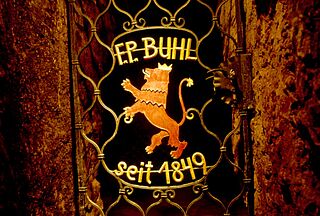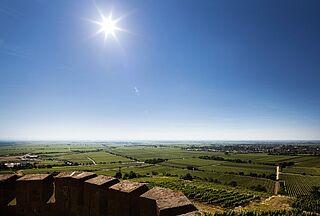Idig
Kendte vinmarker
Idig – Vineyard of the Electors of the Pfalz
This months famous vineyard site is located in the heart of the Pfalz wine-growing region, in Königsbach, a wine village north of Neustadt an der Weinstrasse.
From the top of the hillside vineyard there are wonderful views over the Rhine plain, extending to the Odenwald (Oden Forest east of the Rhine, in the Hessische Bergstrasse region) and the Schwarzwald (Black Forest in Baden). On a clear day, it’s possible to see the silhouettes of the cathedral in Speyer (a UNESCO World Heritage site) and the castle in Heidelberg.
By 1809, the site was recorded in the official land registry as “Im Idig,” but its origins date from at least the late Middle Ages, when it was documented (1387) as “unseres gnädigen Herren Pfalzgrafen 18 Morgen Weingarten im Idischen” – roughly translated – “an eleven-acre vineyard ‘im Idishchen’ belonging to our gracious lord, the count Palatine.” Since the 14th century, it numbered among the properties of the counts Palatine (and later, electoral princes of the Pfalz). Wines from Idig were served at the royal table. The onset of the French Revolution (1792) changed most things in the Pfalz, including the fate of this vineyard. In the decades following secularization, Idig experienced a period of decline under ever-changing ownership, until it was acquired in 1865 by Franz Armand Buhl (1837-1896), whose first-class Idig wines helped restore the site’s image.
Franz Armand Buhl took over his parent’s wine estate in Deidesheim in 1862/1863, and in the years thereafter, built it into a prestigious estate of international renown. He was also a highly respected politician, particularly known as an advocate of social benefits and active on behalf of German wine-growers. For this reason, King Ludwig II of Bavaria conferred him with the title “Reichsrat” of the Bavarian crown. His son, Franz Eberhard (1867-1921), carried on the tradition of producing great, top-quality wines and was a founder and president of the reorganized German Wine-growers’ Association in 1913. Like his father, he also received the Bavarian title of “Reichsrat,” which he incorporated into the estate’s name: Weingut Reichsrat von Buhl.
In the course of property transfers after the death of Franz Eberhard and his wife (there were no more Buhl heirs), Idig was more or less “forgotten” until the early 1990s, when the Christmann family (of Gimmeldingen) purchased choice parcels of the original site – and “put Idig on the map” with recognition and awards by leading German and international wine critics/publications for its top Idig Riesling and Spätburgunder (Pinot Noir) wines. Their Idig wines have numbered among the top ten dry Rieslings in Gault Millau (six of the past 10 vintages) and received the highest rating worldwide for a dry Riesling in Wine Spectator. Weingut A. Christmann has 4 ha/10 acres of holdings in the original portion of the site, 85% planted with Riesling and 15% with Spätburgunder.
Facts & Figures:
Since the German wine law of 1971, when vineyard boundaries were redrawn, the site has been about 16 ha/40 acres in size – considerably more than the original, medieval site of 7.5 ha/18.5 acres.
Some 75% of the site is sloping, and the rest – specifically, the core parcels – quite steep by Pfälzer standards. In terms of microclimate, Idig is south-facing, protected from cold winds by forested slopes to the west, and shaped like a basin, thereby resulting in high temperatures – natural factors, all of which help grapes achieve a high degree of ripeness year after year.
Loam and clayish sand predominate, but the soil of the original parcels is a relatively rare Tertiary marl mixture of limestone and clay underpinned by limestones. According to Steffen Christmann: “The soil is reflected in the wines’ distinctive salty, mineral tone that lends them elegance and a silky texture; ensures that their acidity is well integrated, i.e. even dry wines are never ‘sour’; and enhances their longevity.”
In all, about half the site is planted with Riesling. Other varieties include: Spätburgunder, Silvaner, Saint Laurent (red), and Ortega.
Idig – a name to look for. As Steffen Christmann says: “Even today, Idig wines would appeal to the electoral princes’ “Mundschenken” – the royal keepers of the vineyards/ cellars and official “cupbearers.”
Tips for Tourists:
- Neustadt an der Weinstrasse is one of the largest wine-growing communities of Germany, with nine suburbs – including Königsbach.
- In Neustadt proper, don’t miss the delightful “Elwedritschen” Brunnen (fountain), featuring the “spitting” fabled creatures (half-bird/half-human). Look for the “one who got away” – near the market square – site of the Baroque town hall, the Gothic church Stiftskirche (with the world’s largest cast-iron bell, weighing more than 17 tons), and nearby, the Renaissance courtyard Kuby’scher Hof, the home of Haus des Weines (House of Wine), where you can sample some 30 of the 100 Neustadt wines on sale.
- The Otto Dill Museum features works of the late (1884–1957) impressionist painter (next door is an excellent restaurant – Brezel). Railroad fans won’t want to miss the Eisenbahn Museum behind the main train station.
- Should your travels bring you this way in autumn: enjoy the Deutsche Weinlesefest (German Wine Harvest Festival) in early October, which culminates with the coronoation of the German Wine Queen and a huge, colorful parade the next day.
- The tourist information office has town maps as well as brochures outling great hiking & cycling tours in the vineyards and the Pfälzer Wald (Palatinate Forest), one of Germany’s largest pine and chestnut forests.
Where to wine and dine in Neustadt and its suburbs:
- Altstadtkeller bei Jürgen. Kunigundenstrasse 2. Cozy indoors, beautiful outdoor terrace. Typical regional/seasonal specialties and a good selection of wines. Closed Monday. No dinner Sunday. DC, MC, V
- Brezel (means “pretzel”). Rathausstrasse 32 (between Ludwigstrasse and Sauter Strasse, near market square). The former bakery in a 17th-century half-timbered house is now an upscale wine restaurant with lots of fresh fish on offer. Otto Dill paintings line the walls. Closed Tues. and Wed. MC, V
- Weinstube Eselsburg. Kurpfalzstrasse 62, Neustadt-Mussbach. Typical wine pub named after the suburb’s best-known vineyard, Eselshaut. Artworks by proprietor Peter Wiedemann and his late father line the walls. Idyllic courtyard. Regional/seasonal specialties. Closed Sun.–Tues. No lunch. MC, V
- Rebstöckel/Weinstube Schönhof. Weinstrasse 600, Neustadt-Diedesfeld. Typical wine pub at Weingut Schönhof. Regional specialties and estate’s wines. One guest room and four holiday apartments. Restaurant closed Wed. and Thurs. No lunch. No credit cards.
- Weinstube Kommerzienrat. Kurpfalzstrasse 161/Loblocherstrasse 34, Neustadt-Gimmeldingen. Cozy indoors, small courtyard for dining “al fresco.” Typical regional/seasonal specialties and superb selection of wines. Four, well-appointed holiday apartments. Restaurant closed Thursday. No lunch. No credit cards.
- Nett’s Restaurant-Weinbar at Weingut A. Christmann, Peter-Koch-Str. 43, Neustadt-Gimmeldingen. Chic wine restaurant in a 16th-century vaulted cellar and pretty little courtyard for intimate outdoor dining. Closed Mon. and Tues. No lunch. No credit cards.
Many thanks to Steffen Christmann, proprietor of Weingut A. Christmann, Neustadt-Gimmeldingen, for help in gleaning background information about Idig.


